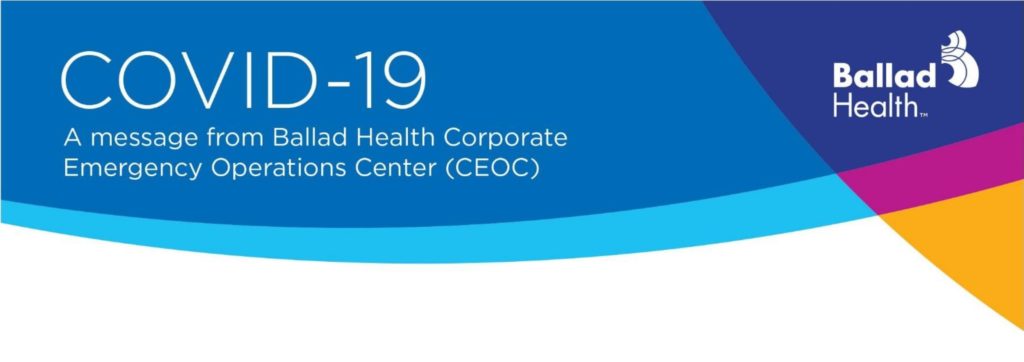
TO: Ballad Health All
FROM: Corporate Emergency Operations Center
DATE: Jan. 5, 2022
TITLE: New CDC COVID-19 guidelines for healthcare workers
ACTION: Please read and cascade to all team members. NOTE: All team members were also emailed these guidelines, including in PDF format.
The Centers for Disease Control and Prevention (CDC) has made significant changes to the guidelines for isolation and quarantine for healthcare workers. Please note there are specific guidelines for healthcare workers, separate from the updates for the general public, which also changed last week. The guidance from CDC is somewhat complex, so if you have any questions, please direct them to your supervisor, who will seek guidance from the CEOC.
The intent of this memo is to provide guidance on how work restrictions will be handled based upon the latest CDC guidance, in the event there is exposure to COVID-19. Ballad Health intends for these guidelines to permit a team member to return to work as soon as possible; they are not intended to require a team member to return to work if the team member is unable to do so because of ongoing symptoms.
Any department with the ability to quarantine and isolate according to conventional strategies will still do so. Conventional staffing is defined as the department not expecting staff shortages due to quarantine. For departments or roles that have the ability to follow the conventional staffing criteria, please refer to this memo and the CDC chart – inserted at the bottom of this message – for those specific guidelines or contact infection prevention for assistance.
Symptomatic team members
- Guidelines for symptomatic team members have not changed.
- Anyone with symptoms must be removed from the work area and referred for testing. The team member will remain excluded from work until results are back and they are cleared to return to work by Team Member Health.
Contingency staffing model
Contingency staffing is applied when staffing shortages are occurring or are expected due to quarantine measures. The following contingency guidelines apply to areas which are not high risk. High-risk areas, such as cancer centers and oncology units, will follow conventional guidelines when determining if COVID-19 positive team members can return to work.
Guidelines for team members returning to work
Team members who have tested positive for COVID-19, but who have been asymptomatic, and are well enough and willing to return to work:
Team members who were asymptomatic throughout their infection and are not moderately to severely immunocompromised are encouraged to return to work if:
- At least 5 days have passed since the date of their first positive viral test (Day 0), and a negative antigen test, if antigen tests are available.
Team members with mild to moderate illness who are not moderately to severely immunocompromised are encouraged to return to work if:
- At least 5 days have passed since symptoms first appeared (Day 0), and
- At least 24 hours have passed since last fever without the use of fever-reducing medications, and
- Symptoms (e.g., cough, shortness of breath) have improved and
- Team member has a negative antigen test, if antigen testing is available.
Team members may return to work if they have had a high-risk exposure to COVID-19, but were not known to be infected with COVID-19, if:
- The team member is vaccinated and boosted, no work restrictions are required for conventional staffing. The team member will be tested on Day 2 and Day 6.
- The team member is vaccinated and boosted, no work restrictions are required for contingency staffing. Testing is not required under contingency guidelines, unless the team member becomes symptomatic.
- The team member has not received all COVID-19 vaccine doses, including a booster dose, as recommended by CDC, to continue to work onsite throughout their 14-day post-exposure period:
-
- If permitted to work, the team member will be tested on Day 2 after the exposure, and if negative, again on Day 6. Date of exposure is considered Day 0.
- The team member will still report temperature and absence of symptoms each day before starting work. Managers must maintain and retain a log of these symptom checks should they be needed for future review.
- They will use a respirator or well-fitting face mask at all times in the facility. The team member must be alone when removing their respirator or mask to eat or drink.
- If the team member develops even mild symptoms consistent with COVID-19, they will either not report to work, or stop working and notify their supervisor and Team Member Health before leaving work.
- If team members are tested and found to be infected with SARS-CoV-2, they will be excluded from work until they meet all Return to Work Criteria.
Defining high-risk exposure
It is important to note that the CDC has changed its definition of high-risk exposure to more closely follow the OSHA (Occupational Safety and Health Administration) Emergency Temporary Standard definition of high-risk exposure.
High-risk exposure is defined as a team member having prolonged contact (closer than 6 feet for a cumulative time of 15 minutes) with a patient, visitor or team member who has confirmed COVID-19 infection and was not wearing a respirator (N95), OR if wearing a facemask, the person with SARS-CoV-2 infection was not wearing a cloth mask or face mask.
In an effort to reduce high-risk exposures, it is imperative that all team members advise the patient to don their face mask before each team member entry into the room. Any issue with visitors who are noncompliant with mask-wearing will be escalated through the appropriate chain of command.





